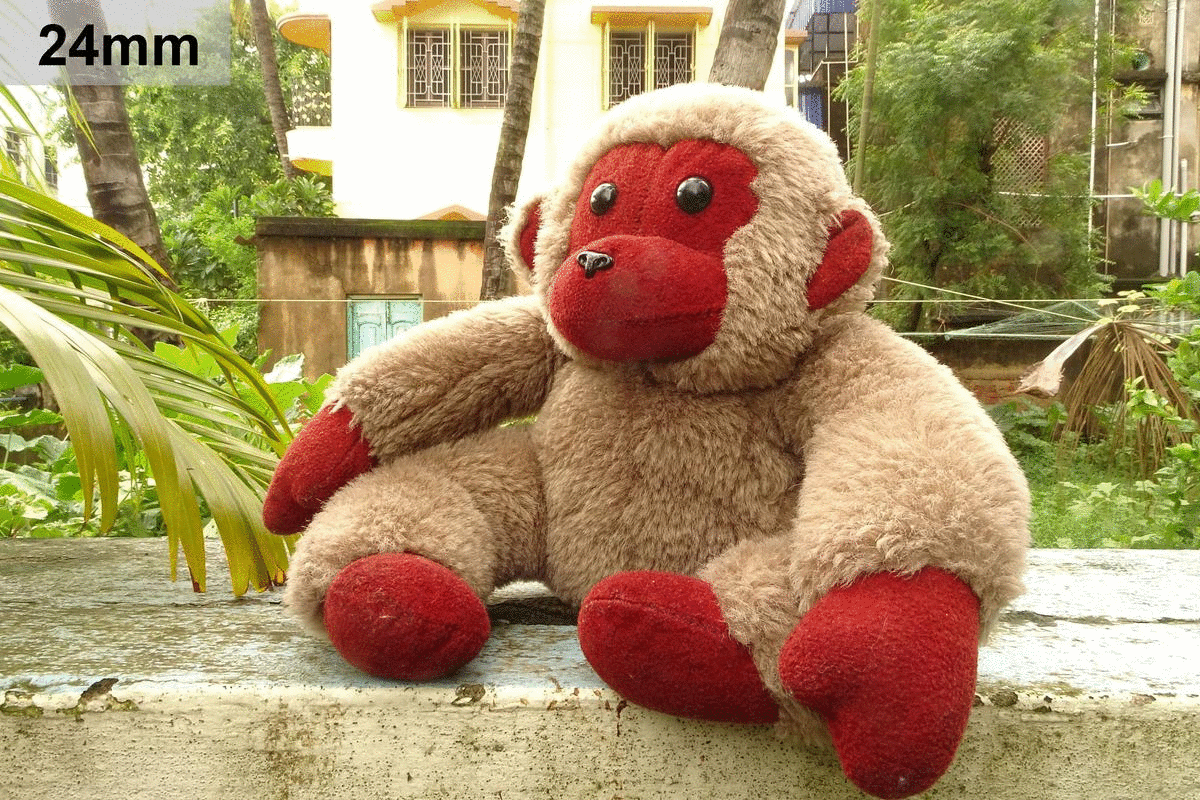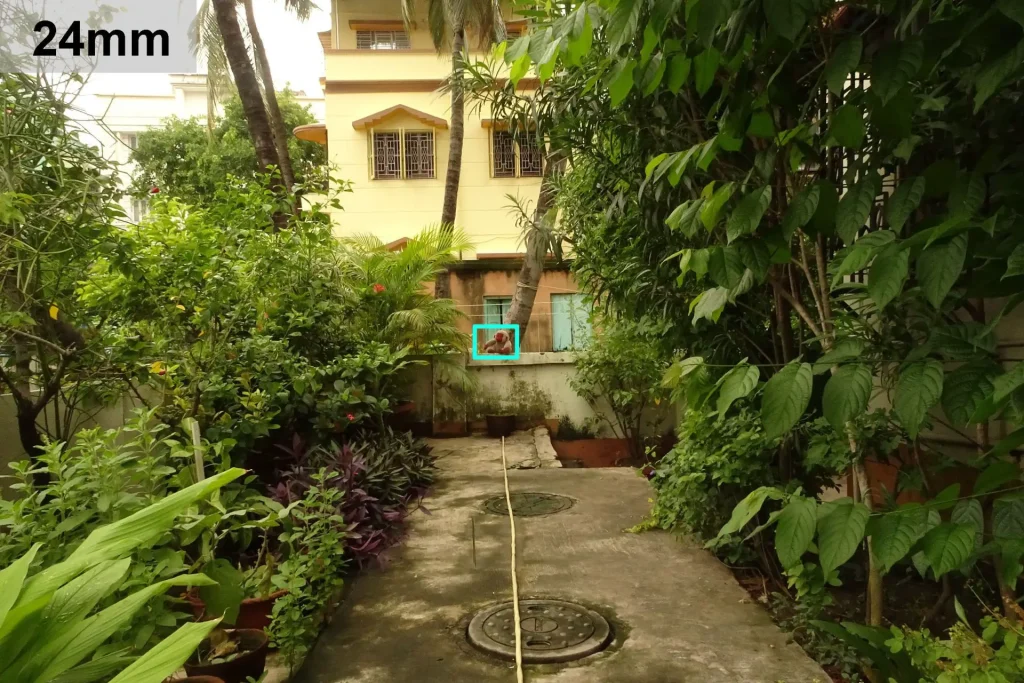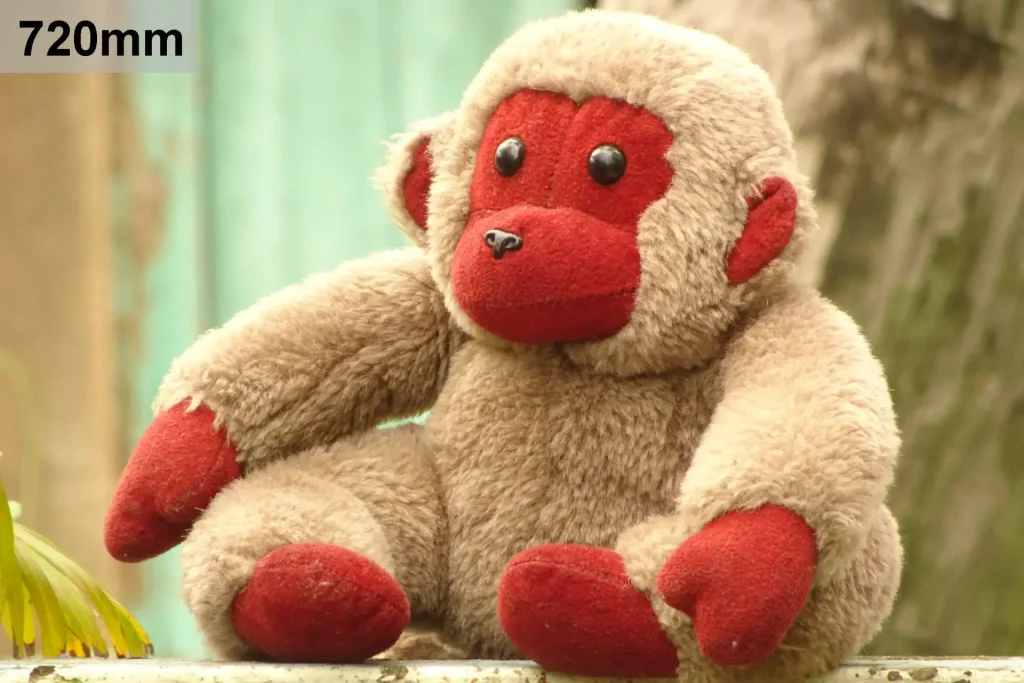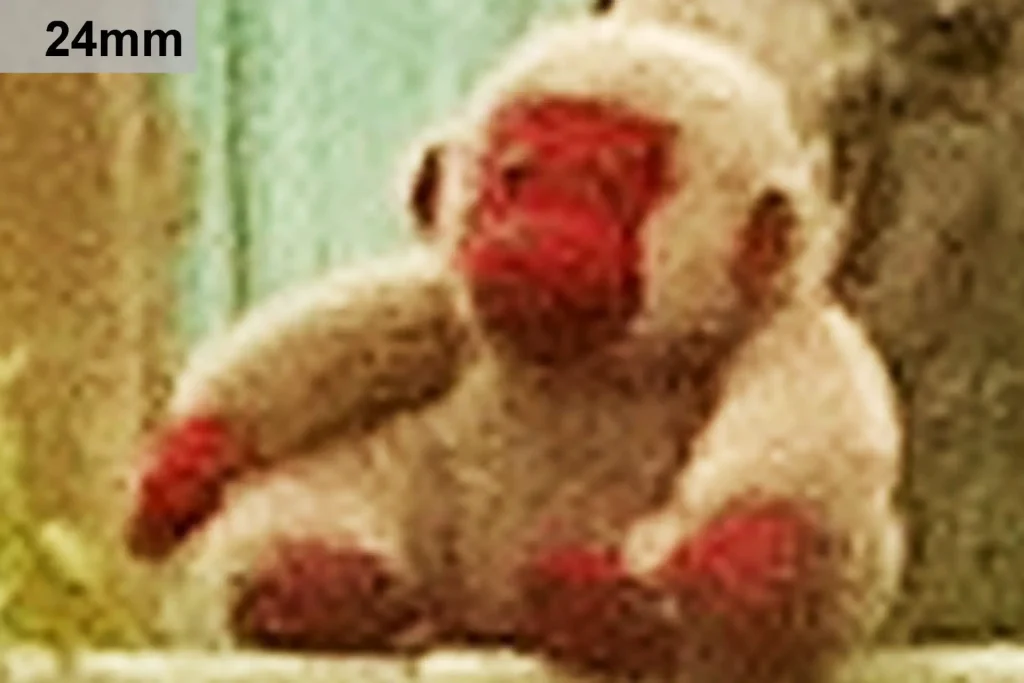When we zoom in or use a longer focal length, the subject looks bigger… other things being equal, of course. But other things need not be equal. We can, for instance, zoom in and move back at the same time – increasing the subject-distance, and thus keeping the subject-size (by which I mean, how much of the frame it occupies) more or less constant. For brevity, adopting a cinematography term, I will call this a “dolly-zoom” – zooming in (or out) while moving away from (or towards) the subject to maintain a constant subject-size.
What happens when we dolly zoom?
I knew the answer in theory, and you probably do too: a change in perspective, specifically, in the relative sizes of foreground and background objects. But that’s theory.
In practice, I’ve never seen a wholly satisfactory demonstration with still photos. So I thought I’d make one myself.

The numbers at top-left, which I use throughout this post, are 35mm-equivalent focal lengths. I am not masochistic enough to try this with film; I used a digital camera with a smaller sensor (for more details, please see below). Other than providing lower resolution and greater depth of field, the smaller sensor makes no practical difference for purposes of this demo.
To me, the two most obvious effects are that as I dolly zoom in, the background appears to loom larger, and simultaneously also seems to become blurrier. So what’s going on?
Perspective distortion
Subject–background relationship
At the widest focal lengths, the background appears (perhaps disproportionately) small and distant. At longer focal lengths, it appears to loom large. In fact, this effect – called perspective distortion – is not due to the change in focal length but the change in subject distance.

In the comparison above, for example, the 180mm shot was taken from over 7 times further away than the 24mm shot. It’s the subject distance, and not the focal length itself, that causes the perspective distortion.
To demonstrate, I took a photo at 24mm from the same camera position and subject distance as I used for the 720mm shot. The blue rectangle shows the 720mm field of view. Quite a difference!

Now here’s a comparison between the 720mm shot and the tiny crop from the 24mm shot, both from the same distance.


Obviously the 24mm crop is pixellated to kingdom come, but the perspective distortion is identical; in the 24mm shot, the background appears to loom just as large. But because the subject occupies such a small part of the uncropped frame, the effect is just not as obvious.
Subject shape
Going back to the 24–180 comparison (or the GIF, for that matter), a subtler difference is in the apparent shape of the monkey itself. Being a three-dimensional object, some of its parts are closer to the camera, and therefore more susceptible to perspective distortion. For example, at wider angles, one of its arms (the one nearer to the camera) appears longer than the other.
Perspective distortion, by the way, is different from radial distortion. Perspective distortion does not bend straight lines, whereas radial distortion (like barrel, pincushion or moustache distortion) does. Even a perfect lens can exhibit perspective distortion, whereas radial distortion is considered an optical aberration.
Depth of field
The second effect seen in the GIF is an apparent reduction in the depth of field. Here’s the 24–180 comparison again.

The background appears blurrier at 180mm, and that makes sense, because at a given aperture (all these photos were shot at f/8), as we all know, wide-angle lenses have more depth of field than telephoto lenses – right? Not quite!
Wide-angle lenses do indeed have greater depth of field than telephoto lenses… when the subject-distance is kept constant. But as Cambridge in Colour explains, if the subject-size is kept constant, as I did here, the total depth of field is virtually independent of focal length.
Depth of field, as the formula shows, is directly proportional to the square of subject-distance, and inversely proportional to the square of focal length. Practically, what that means is that in a dolly zoom, when the focal length increases by a factor of, say, 30 (24mm to 720mm), the subject distance must also increase by a factor of 30 to maintain a constant subject-size. The two increases cancel out, and the depth of field remains constant.
But wait: in the comparison, the background in the 180mm shot does look blurrier? That’s only because, thanks to perspective distortion, the already-out-of-focus background is enlarged relative to the foreground, magnifying and therefore emphasising its blurriness. Generally speaking, anything that’s in focus at 24mm will also be in focus at 720mm. Anything that’s out of focus at 24mm will also be out of focus at 720mm. However at longer focal lengths, the higher magnification of out-of-focus background details will tend to emphasise their “out-of-focusness”.
Implications
What does all this mean in practice? The GIF is just a fun demonstration, nothing revelatory. The implications, if any, are things that photographers have known for decades. If we compare a head-and-shoulders portrait taken with a wide-angle lens and a telephoto, the wide-angle shot will contain more of the background than the telephoto shot. If we want to maintain the same subject-size, the telephoto will enable us – or force us – to shoot from further away. And for a constant aperture and subject-size, the background will appear blurrier with the telephoto lens – not because the depth-of-field is shallower, but because out-of-focus details are magnified.
The demo also shows why the oft-repeated “zoom with your feet” advice has limited value. You can take a roughly similar photo (in terms of subject-size) with both a wide-angle and a telephoto, but only if you’re able to get close enough (with the wide) and far enough (with the tele). And even then, the background will look very different.
Idea and setup
I got the idea for this demo after a chat with Hamish when I was writing an earlier article about using different focal lengths. A similar comparison also appears on Dan Vojtěch’s website – a portrait taken with different focal lengths. But as Hamish pointed out, Dan emphasises the role of focal lengths but doesn’t really talk about the main factor – the change in subject-distance. Besides, his comparison has a featureless backdrop; it looks cleaner than mine, but it doesn’t really show the subject–background relationship.
Incidentally, Fstoppers also has a good video demonstrating how compression is a function of subject-distance, similar to my comparison between the 720mm and the 24mm crop shot.
For the demo, I used my mum’s Sony Cybershot DSC-WX500. It has a 1/2.3-type sensor and a 4.1–123mm zoom (24–720mm in 35mm equivalent). I chose the camera because it has a wider range of focal lengths than any of my own (and because it’s digital!) I mounted it on a tripod and overlaid a grid on the LCD to assist with alignment. For each shot, I positioned the monkey’s left eye at a specific grid intersection, and aligned its lowest extremity with the bottom of the frame. I also used a garden hose (which you can see in the 24mm wide shot above) as a guide, to ensure I was moving the tripod in a more or less straight line.
Truth be told, the alignment was much more fiddly than I anticipated; I’d go so far as to say it was a royal pain. Trying to achieve precise framing at 720mm is hard, even with a stationary subject and a tripod. The tiniest movement throws it off completely. On top of that, Murphy’s Law had a field day, resulting in multiple aborted attempts. First the camera ran out of battery, then it started to rain, then a gust of wind toppled the monkey. The result is not perfect, but I decided it’s good enough. If you’d like to try a similar experiment yourself, by all means, be my guest. As for me, I think I never want to see a stuffed monkey or a zoom lens ever again…
Share this post:









Comments
Philippe Steelandt on Monkeying Around with Focal Length and Perspective – by Sroyon Mukherjee
Comment posted: 24/08/2020
Don't worry, it's normal that it is very difficult to try to do this with a still camera.
You have to do your travelling in stop motion.
The exposition, the wind, the exact position...name it, changes between the different shots.
This is more challenging to do than in a fluid movement and in one take.
Therefore, respect for your try.
And, before you get a perfect "retro-zoom" (or dolly-zoom) with a filmcamera, it takes a lot of "takes".
It works perfectly well when you use it (in a film) to accentuate the disorientation of your character...suppose that he hears in his mobile phone that his girlfriend has another man in her life...or he/she realises that he/she won the lottery.
He has the same size, but the whole world around him changes in perspective...
Comment posted: 24/08/2020
Comment posted: 24/08/2020
John Driggers on Monkeying Around with Focal Length and Perspective – by Sroyon Mukherjee
Comment posted: 24/08/2020
Comment posted: 24/08/2020
Danny Peters on Monkeying Around with Focal Length and Perspective – by Sroyon Mukherjee
Comment posted: 25/08/2020
You've done a great job at illustrating the point. Probably the best I've seen thus far.
If you're a YouTuber . . . you could probably translate this to video (if you have a sweet, massive zoom lens), but it'd likely be an even bigger pain in the watusi.
(Now . . . can someone please do the same thing with 50mm and 90mm Leica lenses? Like, "Here's the shot with the Elmar. Here's with the 'Cron. Here's with the APO 'Cron. Here's with the 'Lux." Etc. I still haven't found that comparison.)
Comment posted: 25/08/2020
Graham Orbell on Monkeying Around with Focal Length and Perspective – by Sroyon Mukherjee
Comment posted: 25/08/2020
Comment posted: 25/08/2020
Comment posted: 25/08/2020